of listening skills of university
students of English
Bojana Petric
Listening comprehension has received considerable attention in the fields of applied linguistics, psycholinguistics and second language pedagogy during the last two decades (Anderson & Lynch, 1988; Flowerdew 1994; Rost, 1990; Underwood, 1989; Ur, 1984). Results of the large body of research have shown that listening is not a passive process, in which the listener simply receives a spoken message, but rather a complex cognitive process, in which the listener constructs the meaning using both her linguistic and non-linguistic knowledge. The importance of the listenersí cognitive and social judgements in the process of listening, in addition to the linguistic knowledge, has been especially emphasised (Rost, 1990).
Although most of the findings relevant to understanding how listening operates come from research into listening in the mother tongue, many of the conclusions have had important implications for the teaching of listening in the foreign language. It is widely recognised today that listening is an active skill, or rather, a cluster of various sub-skills, which are both learnable and teachable. Listening is regarded as an essential element of foreign language proficiency, and as such plays an important role in foreign language programmes. Various methodologies for the teaching of listening have emerged (such as Anderson & Lynch, 1988; Brown, 1991; Ur, 1984). These have had a considerable influence on course design and textbook writing, especially in terms of features of materials for teaching listening (authentic vs. constructed), types of listening tasks, ways of raising learner awareness of the listening process and effective strategies for listening, stages in listening activities, and integrating listening with other language skills. The importance that listening receives in foreign language pedagogy today is reflected at various levels: in one form or another, listening is present in syllabuses, coursebooks and teaching materials available on the market, general proficiency language exams and is even the main focus of specialised courses, such as academic listening.
However, the teaching of the listening skill has been long overlooked in English language teaching in state education in Yugoslavia. There is a lack of research and literature on the teaching of listening, and this skill is also considerably neglected in the practice of teaching English (Dimitrijevic, 1996). The development of all four language skills is outlined as one of the goals of foreign language instruction in the official national syllabus. However, a closer analysis reveals that there is no systematic approach to the teaching of listening at any level of instruction, since there are no activities or materials that specifically focus on the development of this skill. This implies that there is an underlying assumption that listening skills will develop on their own.
This gap between the state-of-the-art methodology for teaching listening and the neglect of this skill in the teaching of English in Yugoslavia was the starting point for an experimental study of listening skills among university students of English. The aim of the study was to compare the development of listening skills in two groups of first-year university students of English: one receiving systematic listening instruction during one semester and the other attending English language instruction without the listening component. The study was conducted during the winter semester of the 1995/1996 academic year at the English Department of the University of Novi Sad. The aim of this paper is to provide an overview about teaching listening, describe the experiment, present the main findings, and discuss their implications for the teaching of English at tertiary level.
Teaching listening
The importance of listening comprehension in the process of learning a foreign language has been emphasised in various models and theories of foreign language learning. Krashen and Terrell (1983), for example, stated that all foreign language acquisition takes place through receiving comprehensible input that is slightly above the learnersí present level, that is, through reading and listening to the foreign language. Some teaching methods, such as Total Physical Response, rely heavily on the listening input at the beginning stages of learning a language (Richards & Rodgers, 1986). Although listening is very important at the beginnerís level, its importance does not diminish as the learners progress to more advanced levels of language proficiency. Practising listening at all stages of learning not only develops this skill but also expands and consolidates other elements of language knowledge, such as vocabulary, grammar and intonation. However, while the importance of listening in language learning is widely recognised today, there are different views as to how to approach the teaching of listening. While some authors, such as Krashen and Terrell (1983), believe in the value of mere exposure to spoken language during which learners unconsciously develop their listening skills and acquire other elements of the foreign language, other authors, such as Rost (1990, 1994) and Ur (1984), agree that in order for learners to benefit from practising listening, it is necessary to develop this skill in a direct and systematic way.
Recent methodologies for the teaching of listening (Brown, 1991; Ur, 1984; Anderson & Lynch, 1988; Rost, 1990; Brown & Yule, 1983) point out that listening develops through the process of exposing learners to listening texts on which they perform tasks specially designed to promote the development of certain sub-skills. Most authors stress the importance of three main factors in the teaching of listening at all levels: listening materials, listening tasks and the procedure for organising listening activities. The interplay of these three factors plays a significant role in designing effective listening activities. As for materials, in selecting listening texts for teaching purposes, their various characteristics have to be taken into account, such as genre, level of authenticity, linguistic and cognitive complexity, density of information, length, speed of delivery and variety or dialect of English. Much more attention, however, has focused on tasks accompanying a text, as it is through doing tasks that skills are developed. According to Harmer (1985), the importance of tasks lies in the fact that they create a purpose, motivation and expectations in learners, which are all characteristics of listening in real life.
In analysing tasks and their effect on the development of listening skills, different classifications of task types have been proposed. Rost (1990), for example, classifies tasks into open tasks, such as note-taking, and closed ones, such as true/false sentences, which differ in terms of whether the level of difficulty is fixed or open. Thus, in open tasks it is the learner who determines the level of difficulty by adapting the task to his or her proficiency level. In note-taking tasks, for example, the quantity and quality of notes that the learner writes down while listening will depend on his or her proficiency and motivation. In contrast, in a closed task such as a true/false exercise, the difficulty level is set in advance, and the learner can either perform the task or fail to do so. It is important to note, however, that the division into open and closed tasks is not based on the level of difficulty itself, as tasks of both types can be of various levels of difficulty depending on task design and the listening material used. What this classification emphasises is that tasks differ in the amount of choice the learner has in his or her response while performing a task.
Another classification outlined by Rost (1990) is based on the factor of time, according to which tasks can be prospective, that is, carried out before listening, simultaneous with listening and retrospective. Each of these types of tasks focuses on a different sub-skill. For example, prospective tasks develop learnersí ability to raise expectations and use them in the process of listening. A prospective task like brainstorming on the topic of the listening activity not only creates expectations but also helps activate the language that the learner will probably need in the process of comprehension. Awareness of different processes involved in each of these types of tasks is necessary in task design so that task features can be used optimally. For example, simultaneous tasks must be formulated in a very simple way, either graphically or textually, so as not to distract the listeners while they are focusing on listening. Similarly, retrospective tasks must take into account the limitations of memory and should not require the learners to focus on memorising a large number of details.
Tasks can also be classified according to the quantity of response required. Ur (1996) distinguishes four categories of responses required in different types of tasks, which range from no response required (e.g., in listening to a story), short responses (such as true/false sentences), long responses (answering questions) to extended responses (such as discussion based on the listening material). Again, it is important to note that the difficulty level is not directly related to these four types of tasks. In other words, a task requiring a short or no response can be linguistically and cognitively more demanding than a task requiring a long response.
As this short overview shows, task type is an important factor in teaching listening. Different types of tasks focus on different stages of the listening process, listening strategies and sub-skills that learners need to develop. The choice of task will therefore depend on the aims of listening instruction at a particular learning stage and on the characteristics of a particular teaching context. Thus, in an academic listening course note-taking tasks will be more frequent than other types of tasks, reflecting the needs of students attending such a course.
As for the procedure for conducting listening activities, most methodologies divide listening activities into three basic stages: pre-listening, listening and post-listening, each of which has a clear aim and function. The importance of pre-listening activities is especially emphasised in recent methodologies, since they not only provide the context necessary for activating the language and background knowledge related to the topic, but also help to raise learnersí expectations and motivation. Post-listening activities, in turn, offer a natural opportunity to link listening with another language skill, as they usually lead on to speaking or writing.
A systematic approach to the teaching of listening requires a careful selection of materials, tasks and procedure at all levels of language learning. At tertiary level of studying English the teaching of listening acquires yet another important dimension: not only is listening practised and developed as part of general language proficiency but also as a necessary element of studentsí study skills. Studying English at university implies listening to lectures and participating in seminars conducted in English, which presents students with demands for concentrated listening to material dense with information for a longer period of time. Furthermore, listening to lectures is accompanied by note-taking, which puts additional pressure on the listeners in terms of time, since several activities take place simultaneously: listening, summarising and writing.
Research into the specific features of academic listening has shown the complexity of this skill. Richards (1985), for example, specifies a list of micro-skills within academic listening as opposed to conversational listening, such as understanding the main points in a lecture, or distinguishing between the main line and digressions. A different classification is offered by Rost (1990), who starts from the assumption that listening sub-skills are grouped into certain clusters, arranged into hierarchies. Both classifications, however, indicate that academic listening is a skill whose development requires special training. These and other findings have contributed to the fact that many universities today recognise the need to offer courses in academic listening at the beginning of university studies, either as special courses or as part of study skills courses, with the aim to train students to develop skills for listening in the academic context (Flowerdew, 1994).
However, at the English Department at the University of Novi Sad developing listening skills, either general or academic, is completely neglected. The concept of language development is based on a traditional model of foreign language learning, with an emphasis on grammar and translation. Although teaching language skills is part of the syllabus, they are practised in isolation, that is, one skill is the focus of a class. Even so, speaking, writing and reading are practised in separate classes, but not listening. At the same time, students are expected to attend lectures in English on linguistics and literature, and many of them experience considerable difficulties. One may conclude that listening is a crucial skill for successful studies at the English Department, but although students are exposed to listening English through attending lectures and classes, this skill is not developed in a systematic way. This observation was the starting point for the research into the listening skills of university students of English.
Research method
The aim of the research was to explore the effect of a one-semester programme of listening instruction on the development of listening skills of first year students of English at the University of Novi Sad. In order to achieve this aim, the development of the listening skill in two groups of university students of English was compared: one group that received regular instruction at the English Department and the other one that received additional systematic listening instruction during one semester.
The research hypothesis was that all studentsí listening skills would improve during one semester of studies, but the improvement would be significantly greater in the case of students who receive listening instruction than in the case of students who attend the same number and type of classes without listening instruction.
In order to test the hypothesis, an experimental research design was applied, with an experimental and a control group, each consisting of 15 students. Both groupsí listening skills were tested at the beginning of the study, using the listening part of TOEFL. The test was administered in a 45-minute session, under the same conditions for both groups. During the nine weeks of the first semester, both groups attended the same type and number of classes, followed the same syllabus, and were taught by the same instructors. In this period the experimental group received instruction aimed at developing listening skills, but these students did not attend any additional classes. Listening activities were carried out within speaking and grammar classes, in 25 mini-sessions (two to three times per week), lasting for 5 to 15 minutes per session, with the actual listening time of approximately 3 minutes per session (87 minutes in total). The control group attended speaking and grammar classes without the listening component. At the end of the first semester, both groupsí listening skills were tested again, using another version of the TOEFL listening test.
The analysis of the data obtained by testing included the comparison between pre-test and post-test means both between groups and within each group, using the t-test, with the level of significance set at p < .01. The groupsí performance on the tests was also compared according to the following criteria: distribution of scores into bands, item difficulty analysis and the comparison of gains (total gain, individual differences and comparison by part of the test).
Participants
The participants were 30 first-year students of English at the English Department, University of Novi Sad, Yugoslavia. The students were divided into two groups by the Department according to its policy to create groups of equal language proficiency. The division was based on entrance exam scores, that is, scores on a test which consisted of five sections: reading, grammar, vocabulary, cloze and speaking. The comparison of the entrance exam showed that the groups did not differ with regard to their language proficiency to a considerable extent. Furthermore, the groups did not differ significantly with regard to gender distribution (14 female and 1 male students in the experimental group, 13 female and 2 male students in the control group) or nationality (all were Yugoslav nationals and speakers of Serbian). A questionnaire was administered at the beginning of the experiment to obtain other information about the participants that could affect the results of the study, such as years of learning English, longer stays in English speaking countries and attendance of specialised exam preparation courses (e.g., TOEFL, IELTS or UCLES exams). None of the above was found to be a significant factor (see Table 1). Most students in both groups had only attended English classes as part of the official state school curriculum, and only a small number (2%) had had additional input from either attending English language courses or staying in an English language country for a longer period of time.

Materials
The listening test
The assessment of the studentsí listening skills was carried out using the listening part of TOEFL. The test consists of three parts, each of which assesses the ability to comprehend a different type of listening material: short sentences (20 items), short conversations (15 items) and talks or longer conversations (15 items). The maximum score is 50 in this part of TOEFL. Although this test has many weaknesses, most of which are related to the fact that it relies on one testing technique only, that is, the multiple choice technique, the test was nevertheless selected for the purposes of this experiment for several reasons. First of all, students are familiar with the multiple-choice format since it is frequently used in language testing in the Yugoslav context. In this way it was ensured that test format would not influence test scores. Secondly, the division of the test into three parts, testing three different types of listening: isolated utterances, short dialogues and longer stretches of speech, allowed for comparison and more detailed analysis of scores. Finally, the testís scoring system provided for objective and clear comparison and analysis.
Experimental programme of instruction
The initial consideration in designing the experimental programme of listening instruction was to determine how to incorporate listening activities within the existing types and numbers of classes aimed at the development of language proficiency. Language instruction at the English Department of the University of Novi Sad consists of the following classes: reading skills (one 45-minute lesson a week), speaking practice (one lesson), writing practice (two lessons), translation from and into English (two lessons), grammar (two lessons) and pronunciation practice (one lesson). The aim of the experimental programme was not only to practice listening but also to integrate listening activities into the existing classes so as to avoid fragmentation and practising listening in isolation. Based on these considerations, and on the willingness of instructors to take part in this study, three types of classes were selected as the most appropriate framework for the listening programme: speaking, writing and grammar classes. Wherever possible, listening activities were planned in such a way as to maintain a link with other activities in the lesson. For example, a listening activity was used as a way to introduce a topic for discussion or writing.
The experimental programme of listening instruction was carried out in 25 mini-sessions over nine weeks, two to three times per week. Each mini-session lasted from five to fifteen minutes and consisted of three stages: a pre-listening activity, listening, and a post-listening activity. It is important to note that the duration of the actual listening time was much shorter: one to six minutes per session (total listening time: 87 minutes). In other words, the exposure time was shorter than work on the listening material through performing tasks and giving feedback.
Listening materials were compiled on the basis of available materials for the upper-intermediate level. The materials were selected in a way to ensure that there was a range in terms of varieties of English (i.e., British or American), number of speakers (monologues and dialogues), length (one to ten minutes), topics (mostly topics of general interest, such as health, environment and politics), density of information (e.g., news versus casual conversation between friends), and genres (for instance, lecture, conversation, interview). All materials were Ďcontrolled authenticí, that is, authenticity was maintained in that the speakers did not read a written text, and features of speech such as hesitations, fillers, repetition and incomplete sentences were kept; however, noise and other factors which would affect listening to a cassette (without contextual and visual information) were controlled. The materials were compiled and recorded on a cassette. At the beginning of the programme, the students received study packs with materials necessary for performing the listening tasks.
Listening tasks were selected according to the materials and aims in terms of developing different types of listening skills, such as listening for gist and listening for specific information. The following types of tasks were included: note-taking, gap-filling, multiple-choice, true/false sentences, filling tables and answering questions. Tasks included both closed and open ones (e.g., true/false sentences vs. note-taking) and also differed in terms of the type of the response required (e.g., multiple choice tasks vs. answering questions). Tasks requiring a more complex response, such as note-taking, prevailed, as they reflected studentsí needs at this level of study. However, neither the materials nor the tasks were specialized in nature, but rather covered topics of general interest and included non-academic genres in addition to lectures.
The purpose of these activities was not to test but rather to develop studentsí listening skills. Special emphasis was, therefore, placed on the feedback procedure. If students had difficulties in performing a task, listening to the material or its specific parts was repeated and answers discussed in class. In this way, discussions aimed at developing studentsí awareness of the process of listening and effective listening strategies.
Results and discussion
Test scores obtained from the pre-test and post-test (Table 2) were compared and analysed according to a number of parameters. Although the control group scored numerically higher than the experimental group on the first test, while the experimental group had higher scores than the control group on the second test (as can be seen in Table 2), t-test analysis showed that these differences between the groups were not statistically significant (t = 0.833, p > 0.01). However, the within-group comparison showed that the difference between the pre-test and post-test means was statistically significant in the experimental group (t = 5.875, p <0.01), but not in the control group (t = 2.4, p > 0.01). This indicates that although both groups performed better on the second test, it is in the experimental group that the gain in scores can be attributed to factors other than chance, that is, in this case to the listening instruction.
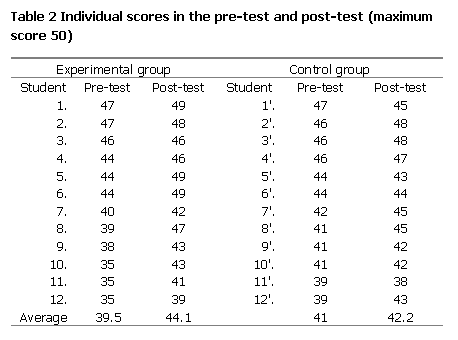
The comparison of gains the two groups achieved further shows that the experimental group achieved greater progress than the control group. In the experimental group students scored 4.7 points higher on the post-test, in comparison with control group studentsí average gain of 1.2 scores. T-test analysis showed that the difference in the gains between the two groups is statistically significant (t = 3.57, p < 01), which indicates that the experimental group benefited from the listening instruction.
The comparison of the differences between the pre-test and post-test range and standard deviation shows that the spread of the scores was more even in the group which received listening instruction (the range decreased from 16 on the pre-test to 12 on the post-test, the standard deviation from 5.3 to 3.8) , whereas in the control group the scores remained equally spread (the range decreased from 16 to 15, the standard deviation from 4.8 to 4.7). This can also be seen in Tables 3 and 4, which show the distribution of scores in bands. These data indicate that the programme of listening instruction had an effect on all studentsí progress, whereas in the absence of such instruction some students achieved better scores while others did not.
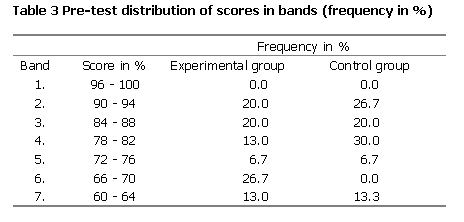
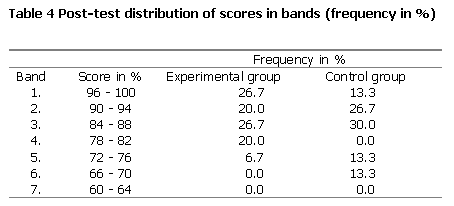
Further analysis of the individual scores (Table 5) shows that, while all students in the experimental group benefited from the listening instruction, some students achieved considerably better results (33.4% of the studentsí gain on the post-test was greater than 10%). In contrast, 33.4% of the students who did not receive such instruction did not make any progress on the post-test at all. In addition, the students in the control group whose scores did improve did so only to a limited extent (none more than 10%).
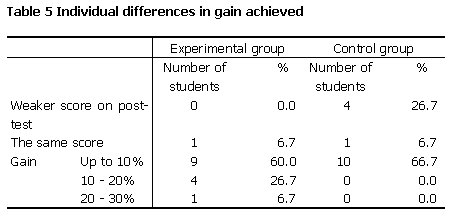
The comparison of progress made in each of the three parts of the test separately (Table 6) shows in which areas the programme was the most effective. First of all, it is important to note that the experimental groupís scores improved on all three parts of the test, whereas the control group made some progress in the first two parts of the test (listening to short sentences and short conversations) but not in the third one (listening to talks or longer conversations). This indicates that without listening instruction no progress was made in the part of the test which assesses abilities to listen to a longer stretch of speech (such as a talk or mini-lecture) and make inferences about what the speaker implies. Although all the students were exposed to lectures and classes held in English, only those students who received focused and systematic instruction developed abilities for successful listening to longer listening texts. In other words, exposing students to listening to lectures alone will not necessarily contribute to the development of their listening skills.
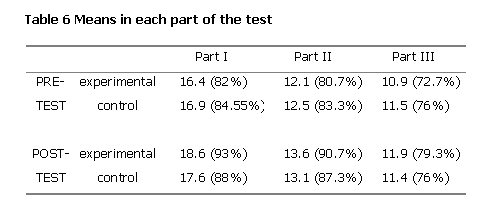
Finally, the analysis of item difficulty revealed another difference between the two groups. The number of items that 50% or more students in the experimental group answered incorrectly decreased from 7 to 2. In the control group the number of such items remained the same (n = 4). Unfortunately, it must be admitted that the nature of the listening process makes it impossible to determine with certainty the reasons why a particular item was difficult. It can often be related to either problems in understanding words, the meaning of a grammatical structure or intonational pattern, or problems in inferencing and understanding the context.
Conclusion
This experimental study showed what effect a one semester programme of listening instruction had on the development of studentsí listening skills. The hypothesis that listening skills of students will develop to a greater extent as a result of explicit instruction was confirmed. The difference between the pre-test and post-test means in the experimental group was statistically significant, and so was the difference in the gain between the two groups. However, one needs to be cautious in drawing conclusions from the data obtained. It is necessary to bear in mind that the study was conducted with a small sample, over a short period of time and that the programme of listening instruction was a small segment of foreign language instruction in general.
Nevertheless, several parameters clearly indicated the progress achieved in the group that received listening instruction: all students benefited from the teaching of listening, and their progress was evident in different areas. In contrast, without systematic teaching of listening, listening skills developed in the case of a certain number of students only. Why some students are able to develop their listening skills without explicit listening instruction and others are not would be an interesting subject for further investigation.
Although this study was conducted with a small sample, using one listening test only, the results indicate the value of listening instruction at tertiary level of teaching English and suggest that listening practice should be an integral part of language development instruction at university level. Further research is necessary in order to determine how such instruction should be incorporated into language development programmes at tertiary level in different contexts.
References
Anderson, A., & Lynch, T. (1988). Listening.
Oxford: Oxford University Press.
Brown, G. (1991). Listening to spoken English. 2nd
edition.
London: Longman.
Brown, G., & Yule, G. (1983). Teaching the spoken
language. Cambridge: Cambridge University Press.
Dimitrijevic, N. (1996). O zapostavljenim jezickim vestinama
(On neglected language skills). Glossa, 2, (1) 5-7.
Flowerdew, J. (Ed.). (1994). Academic listening: Research
perspectives. Cambridge: Cambridge University Press.
Harmer, J. (1985). The practice of English language
teaching. London: Longman.
Krashen, S. D., & Terrell, T. D. (1983). The natural
approach: Language acquisition in the classroom. Oxford: Pergamon.
Richards, J. C. (1985). The context of language teaching.
Cambridge:
Cambridge University Press.
Richards, J. C., & Rodgers, T. S. (1986). Approaches
and methods in language teaching. Cambridge: Cambridge University Press.
Rost, M. (1990). Listening in language learning. London:
Longman.
Rost, M. (1994). Introducing listening. Harmondsworth:
Penguin.
Underwood, M. (1989). Teaching listening. London:
Longman.
Ur, P. (1984). Teaching listening comprehension.
London: Longman.
Ur, P. (1996). A course in language teaching: Practice
and theory.
Cambridge: Cambridge University Press.
Bojana Petric taught ELT methodology at the English Department of the University of Novi Sad, Yugoslavia. She now teaches academic writing at the Central European University in Budapest.